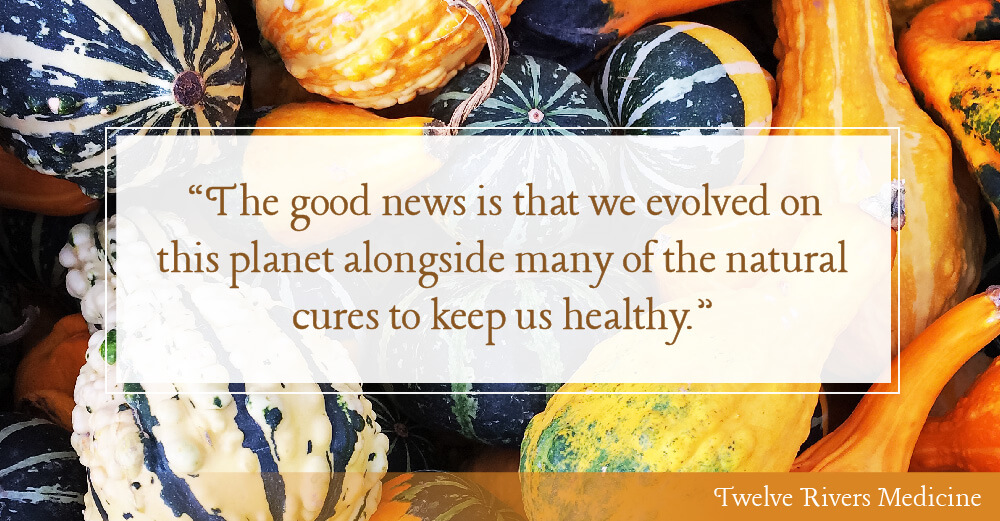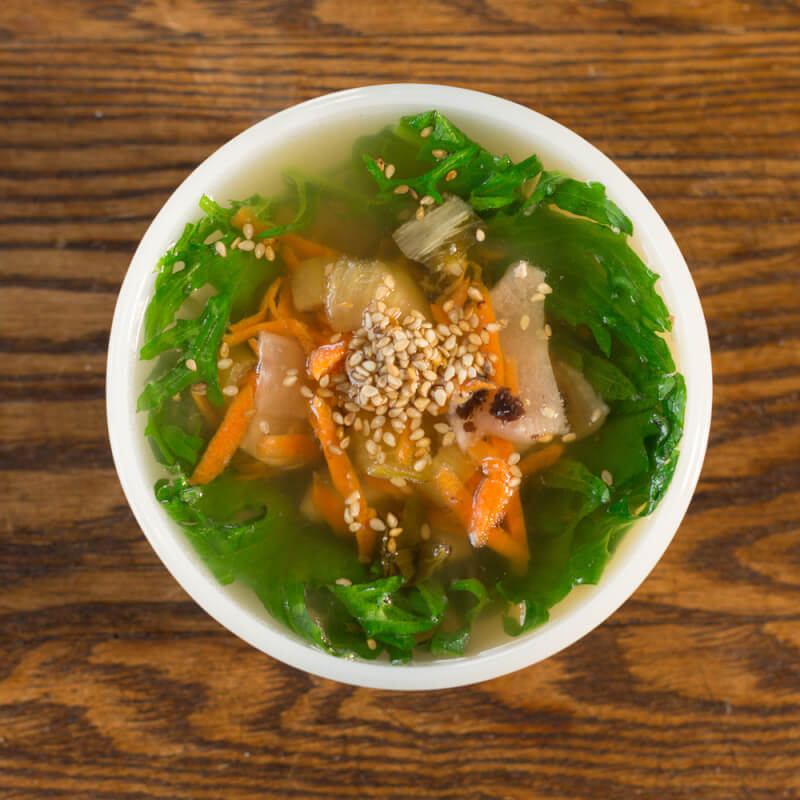The nights have become colder and if one is caught after dark without a coat, the chilly wind prevails. Collars are lifted, sweaters are wrapped tight. The cough drops are sold out at the local health food store. Thicker blankets are hauled out of the closet.
The heat is yet to be turned on in my drafty, old apartment building, but the nights are dropping down to the low fifties. And still, the high arc of the sun brings warmth to our backs, creates the illusion of an Indian summer. When the wind picks up there is the skittering sound of dried leaves.
I would recommend that when the weather turns you go home and make chicken soup with onions. Or stewed pears.
Nibble on some daikon radish. Wrap a scarf cozy around your neck. Get knitted hats and gloves out of the closet. Sip on ginger tea with honey. Because who wants to be one of the people at the co-op fighting over the last five dollar bag of cough drops just to get you through the day? Who wants to end the glory of summer with a cold?
Fall Energetics
Chinese Medical theory explains how harmonizing our habits with the seasonal transitions can help us enjoy a healthy, contented autumn and winter.
With the weather changes comes an adjustment time for the body. The outward energetic becomes inward. The skin that celebrated sunshine must now protect from wind and cold. It takes the body a moment to understand that everything has changed. In that time we are vulnerable to “the wind that carries a thousand diseases.”
This is the concept in Chinese medicine that wind has the power to bring illness into the body if the body is not protected. A “cold” in Chinese medical vocabulary is called a wind cold. The most susceptible places on the body to wind cold- the neck and the upper back- are the same places that love to catch a last ray of summer sunshine.
The good news is that we evolved on this planet alongside many of the natural cures to keep us healthy. The foods that are abundant in the fall seasons-
- root vegetables
- squash
- members of the alum family (garlic and onions)
- pears and apples
- nuts and seeds
- pungent herbs and spices
These are the things that can keep us healthy through the seasonal transition. In the summer we tend to crave cold foods and beverages. These are fine when the temperatures around and inside us are high, but as the shift into cooler, shorter days comes upon us, it is important to also shift our eating habits.
Too many cold, raw foods in the fall and winter seasons build up dampness and mucus in the system. We are given a list of “healthy” foods and eating habits by food trend culture that does not seem to take into account our location, season, body constitutional type, or our current health problems and illnesses. There is no one healthy way of eating that fits all people through all seasons. The natural world knows this, and so do our bodies, if we choose to listen to them.
The Season of Metal
In Chinese medicine and philosophy, the Fall season is associated with the metal element and the organ systems of the Lungs and the Colon. These are a yin yang organ pair that share some fundamental energetics.
The Lungs are responsible for drawing in pure air, exhaling impurities and descending and disseminating the pure qi that has its origin in the inhalation throughout the body.
Disorders of the Lung include any breathing disorders, allergies, immune deficiencies, autoimmune disease, and skin problems, as well as emotional issues of inappropriate grief and boundary setting. The Lungs are known in Chinese Medicine as the organ that loathes cold and dryness.
A happy Lung is a warm, moist Lung, flexible enough to expand, deflate, and circulate qi. Foods that benefit the Lungs tend to have warm and moistening energetics.
Preparing for the seasonal change from summer to fall can help you avoid the common cold or flu, and if you live in a place that becomes cold, dark and gray in the fall, it can also help combat the emotional impact of seasonal affective disorder or mild depression.

Transitioning one’s social activities from beach time, bar-b-ques and sports to dinner parties, craft nights and fall hikes with a thermos of tea can prevent a feeling of isolation.
The Colon, or Large Intestine, is responsible for appropriate letting go, in every sense of the term.
Any intestinal disorders including diarrhea, constipation, leaky gut, inflammatory bowel disease, hemorrhoids, and fatigue are in the realm of the Colon. Even issues of emotional letting go- living in the past, holding on to relationships and ideas that are no longer healthy- can be related to a Large Intestine imbalance.
Many people experience these Lung and Large Intestine symptoms more intensely in the fall season. Paying attention to your body and eating the foods that grow abundantly through the fall season in your climate can reduce these symptoms.
In the summer I live on fruit and cold salads, grilled meat and fish, and I hardly think about food.
I know the season is transitioning into fall without even checking the temperature, because suddenly I crave soup and lasagna, baked squash and steamed leafy greens. The burners are going, the cookbooks are out and full of bookmarks, the grocery bags are full, there’s bone broth with scallions and ginger for breakfast and root vegetable bake for dinner. It is a cozy time for warm, cooked food and quiet activities, gatherings around a fire or over a steaming pot.
Ten Food-Based Medicinals to Promote Autumn Health
- Bone Broth If you haven’t been turned on to this simple, super nutrient-rich food, now is your time to get familiar. Full of protein, minerals and amino acids, bone broth has been shown to improve digestion, immunity, joint strength, sleep, energy and even enriches the collagen in your skin. I recommend using grass fed animal bones (chose your favorite) because they have more nutrient density than conventionally raised meats and are raised without antibiotics and hormones. The good news is that you can use the bones multiple times, to make literally gallons of bone broth (recipe to follow).
- Ginger In the world of Chinese medicinals, ginger is essential to treating a wind-cold attack. Ginger releases the exterior, where wind attacks first begin, flushing out the pathogen before it reaches the interior of the body. It warms and settles the stomach for ease in digestion, it transforms phlegm and mucus and resolves toxicities in the body. Ginger is also considered analgesic, antibacterial, anti-infammatory, antiparasitic and hepatoprotective (prevents damage to the liver) to name a few of its benefits. Boil it for 10-15 minutes in water for tea, throw it into soup stock, grate it into stir-frys and sauces. Ginger is considered a longevity root.
- Onions/Garlic/Scallions The alum family has much to contribute in the way of warding off cold and protecting the body’s immune system. Alums have a place in every medicinal tradition. From a Chinese Medical perspective, they release the exterior and induce sweating (to push pathogens out) and clear nasal congestion. They boost the immune system and protect the heart. Not everyone tolerates Alums. Notice if you have a digestive reaction.
- Daikon Radish Daikon has the pungent flavor and white color associated with the metal element and the Lung and Colon. It is known to address food stagnation and ease breathing by clearing phlegm from the Lungs.
- Miso A Chinese medicinal formula to treat the early onset of a wind-cold from the 3rd century medicinal handbook Emergency Formulas to Keep Up One’s Sleeve is simply made from fermented soybeans and the whites of scallions. If you’ve been underdressed in a windstorm, stressed, or hanging out with a sick person, a steaming bowl of miso soup with scallions could keep you healthy. Miso is full of probiotics that boost the immune system living in your intestines.

Delicious miso soup with vegetables
- Honey nourishes the lung and resolves phlegm. It moistens the throat and helps resolve cough.
- Pears stewed pears are also considered moistening to the throat and Lungs.
- Peppermint and Eucalyptus Essential Oil Both of these essential oils are known to protect the body from wind invasions. They can be sniffed right out of the bottle daily, before or after being around sick people, or when flying on an airplane to prevent illness. One-three drops can be added to a cup of boiling water and the steam can be inhaled, or the oils can be added to salts in a bath.
- Cinnamon Another super herb of the Chinese Medical world, cinnamon has a long list of benefits including boosting the protective qi of the body, warming the channels and dispersing cold for aches and pains associated with cold. It is antioxidant, anti-inflammatory and cardio-protective.
- Vitamin D Research is showing that Vitamin D is essential for a healthy immune system. Most research suggests that the best way to get Vitamin D is from limited sun exposure: 15 minutes-2 hours a day depending on your skin pigmentation and location. For times when sun is scarce and bare skin may be even more scarce, 4000-6000IUs of Vitamin D drops can help boost the immune system and the mood, something many of us need in the colder, darker months. If you suspect you may be low in Vitamin D, consult your naturopath or doctor.
Recipes
Bone Broth
A highly nourishing, protein and mineral rich food, excellent for intestinal health and rebuilding of the gut lining. A great item to have in the fridge and freezer for easy reheating. You can sip on the broth by itself or add veggies (and meat) to make a quick soup. You can use the broth instead of water for steaming and boiling other foods (adds great flavor and nutrient value). Soup bones can be purchased from most butcheries and grocery stores. The joints and marrow-bones are best, where the bone has been cut so you have access to the inside of the bone.
Any bones will work. Suggestions are: buffalo, beef, chicken, lamb, turkey, pork. You can crack poultry bones with a hammer before boiling to get to the marrow. A left over chicken or turkey carcass is perfect.
- Put bones and joints (they can contain meat as well) into a large pot or slow cooker. Fill with water and add salt to taste.
- Cook covered on low for 3-24 hours. The longer you cook the bones, the more they will yield. Adding a couple tablespoons of apple cider vinegar to the water and soaking the bones for 30 minutes before turning on the heat will help extract minerals. Add peppercorns to the broth if you wish.
- Keep adding water as it boils down to get the most out of your bones and use them several times each!
Root Vegetable Bake
A simple and delicious way to cook any of the abundant fall root vegetables now showing up farmers markets and grocery stores.
- Pick your favorite root vegetables in an array of colors and flavors. Peel and chop into 1-inch cubes. Add chopped onion and whole garlic cloves. Add chopped rosemary, parsley, oregano, thyme or any other herb you like.
- Toss with enough olive oil to lightly coat all the root cubes. Salt and pepper to taste.
- Bake on 350, first covered to allow the roots to cook in their own juices and then uncover to brown the last 10 minutes. Roots typically takes between 30 and 60 minutes to become soft.
What’s Your Favorite Fall Comfort?
Comment below with your favorite fall foods, vegetables, or self-care that helps you transition into the shorter autumn days and cooler autumn nights.
Looking for help? Whether it be the tingle of a cold coming on or help thriving in this new season, schedule an appointment »


